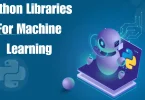Have you ever noticed how YouTube always seems to recommend the exact video you were thinking of watching? Or how your phone automatically sorts your photos into categories like “food,” “beach,” or “selfies”? That’s not magic—it’s machine learning in action!
Believe it or not, machine learning isn’t as complicated as it sounds. You don’t need to be a computer genius to understand it. It’s actually a lot like how we humans learn from experience—only this time, it’s computers doing the learning using data.
So whether you’re a student curious about tech, a working professional hearing the term everywhere, or just someone who loves cool new ideas, this guide will walk you through what is machine learning in simple words?—step by step, with easy examples you’ll actually relate to.
Let’s dive in and demystify the tech that’s quietly powering your everyday life!
What Exactly Is Machine Learning?

Machine learning is a branch of Artificial Intelligence (AI). It allows computers to learn from experience, without being explicitly programmed for every single task.
Still confusing? Let’s put it this way:
Machine learning is how we teach computers to “learn” from data, just like humans learn from experience.
Imagine you’re learning how to bake cookies. The more you bake, the better you get at knowing the right time to take them out of the oven, what ingredients work best, or how to avoid burning them. Machine learning works similarly. The more data (or examples) you give a computer, the better it becomes at doing its job.
Why Is Machine Learning Important?
Machine learning unlocks the power of data. It’s the reason why:
- Netflix recommends shows you might like
- Your phone recognizes your face
- Google finishes your sentences
- Spam doesn’t flood your inbox
- Self-driving cars are becoming possible
These machines aren’t just working—they’re learning and getting smarter based on how we interact with them.
How Does Machine Learning Work?
Let’s walk through the process of how machine learning works, step by step, in a way that makes it easy for anyone to grasp.
Step 1: You Feed the Computer Data
Think of data as examples or experiences.
Just like a child learns what a cat is by looking at many different cats, a computer needs to be shown lots of examples to learn. For instance, if you’re teaching it to tell the difference between cats and dogs, you’d show it thousands of pictures, each labeled either “cat” or “dog.”
These images could include:
- Cats of all shapes and sizes
- Dogs with different fur colors and breeds
- Pictures taken from different angles and lighting
This collection of images is called the training data. It’s the foundation the machine uses to start learning.
Step 2: The Computer Finds Patterns
Once the computer has seen enough data, it starts analyzing it to look for patterns.
For example, it might notice:
- Cats often have pointy ears and shorter snouts
- Dogs might have longer noses and floppy ears
- Cats tend to sit differently than dogs
- Backgrounds or contexts may be similar for certain animals
It doesn’t “see” things like we do, but it picks up on mathematical patterns hidden in the pixels of the images. This process is done using special algorithms (a fancy word for step-by-step instructions or formulas).
So instead of remembering each image, it remembers what makes a cat look like a cat based on the features it has detected.
Step 3: It Makes Predictions
Now comes the exciting part—putting the machine to the test!
You give it a brand-new picture it’s never seen before. Using what it has learned from all those earlier examples, it now tries to guess:
“Is this a cat or a dog?”
If it has learned well, it might say:
“This is 95% likely to be a cat.”
“This is 5% likely to be a dog.”
This is called a prediction, and the system can now repeat this process again and again—getting better over time.
Let’s Use Alexa As an Example
Let’s bring it home with a real-life example: Amazon Alexa.
When you first get Alexa, you might say, “Play my favorite station.” She picks the one you play most often. Over time, she learns:
- What music you like
- What time you usually listen
- If you skip certain songs
- If you turn the volume up for upbeat songs
All of this learning happens automatically, without you giving any complex instructions. That’s machine learning.
You may also like to read this:
Laptop Comparison For Students 2025: Affordable Picks
Smartwatch Reviews Which Is Best Top Picks For 2025 Buyers
5 Best Smartphones Under ₹25000 In 2025 For Gamers
How To Create A Strong Password That’s Secure And Easy
Realme Vs Samsung Budget Phone Review: Full Comparison
Best Tablets For Reading And Work: 2025’s Top 5 Compared
Real-World Examples of Machine Learning Around You
You may not notice, but machine learning is literally all around you:
| Everyday Tool | How Machine Learning Helps |
| Facebook/Instagram | Recommends posts or reels based on your likes and scroll habits. |
| YouTube | Suggests videos that match your interests. |
| Google Maps | Learns traffic patterns to give faster routes. |
| Netflix/Spotify | Personalizes your suggestions based on your watch/listen history. |
| Online Shopping | Recommends products you’re likely to buy. |
| Voice Assistants | Understands and improves from how you speak. |
| Gmail | Filters out spam using email data patterns. |
Every click, skip, like, or purchase helps these systems get better at helping you.
How Is Machine Learning Different from Traditional Programming?
Let’s say you want a computer to recognize a cat.
- In traditional programming, you have to write rules: “If it has whiskers, four legs, and meows, it’s a cat.”
- In machine learning, you just show it 1,000 pictures of cats, and it figures out the pattern by itself.
So instead of telling the computer what to do step-by-step, you just give it data and let it learn on its own.
Types of Machine Learning (Made Simple)

Here are the three main types of machine learning you might hear about:
1. Supervised Learning
You give the computer data with the correct answers.
Example: Show 1,000 pictures labeled “cat” or “dog,” and it learns to recognize the difference.
2. Unsupervised Learning
You give the computer data without answers, and it finds patterns on its own.
Example: Feeding it customer purchase data and letting it find groups of people with similar buying habits.
3. Reinforcement Learning
The computer learns by trying, failing, and improving through rewards or punishments.
Example: A robot learning to walk by trial and error.
Why Is Machine Learning the Future?
- It automates tasks humans do.
- It finds patterns humans miss.
- It improves decision-making in medicine, finance, transportation, and more.
- It makes technology personalized and interactive.
In a world with more data than ever before, machine learning is how we turn that data into something meaningful and powerful.
Can Machines Really “Think”?
One of the most common questions people ask is:
“If machines are learning, does that mean they’re thinking like humans?”
The short answer is no—at least not yet.
Machine learning helps computers analyze, recognize, and predict, but it doesn’t mean they understand things the way humans do. They don’t feel emotions, have opinions, or truly understand the meaning behind the data. What they do is follow mathematical models and algorithms to find patterns.
For example:
- A human might see a dog and think, “What a cute puppy!”
- A machine sees pixels, edges, and colors, then compares them to its learned patterns and says, “This is likely a dog with 92% confidence.”
So, while it might feel like machines are “thinking,” they’re actually just calculating really fast based on what they’ve seen before.
Where Is Machine Learning Used Today?
Let’s go beyond Netflix and Alexa and explore some impressive, real-world uses of machine learning:
Healthcare
- Diagnosing diseases like cancer using image scans
- Predicting patient health risks
- Developing personalized treatment plans
Banking and Finance
- Detecting fraudulent transactions
- Automating credit scoring
- Predicting stock market trends
Self-Driving Cars
- Reading road signs
- Detecting obstacles
- Making driving decisions in real time
Agriculture
- Monitoring crop health with drones
- Predicting weather impact on farming
- Automating harvesting with smart machines
Gaming
- Creating smarter, more adaptive opponents
- Personalizing player experiences
- Automating level design with AI-based creativity
As you can see, machine learning is changing industries—not just our everyday apps, but also life-saving and world-improving technologies.
Does Machine Learning Have Any Downsides?
While machine learning is powerful, it’s important to also understand its limitations:
1. Data Dependency
If the data is biased, outdated, or incorrect, the results will also be flawed. That’s why machine learning models need clean, accurate data.
2. Lack of True Understanding
Remember, machines don’t understand why something happens. They just spot patterns. That can lead to mistakes in unusual or unpredictable situations.
3. Privacy Concerns
Because machine learning systems rely on data—especially personal data—there’s always a risk of misuse. That’s why companies must follow strong data protection laws.
4. Job Shifts
Automation through machine learning may replace certain tasks or jobs. But it also creates new types of jobs in tech, data science, and AI development.
Can Anyone Learn Machine Learning?
Absolutely, yes!
Even though machine learning may sound super technical, it’s something anyone can start exploring, especially now with so many beginner-friendly courses, apps, and tutorials.
If you’re curious, here’s how you can begin:
- Start with basic math (like statistics and algebra)
- Learn a programming language like Python (very popular in machine learning)
- Try hands-on platforms like Google’s Teachable Machine or Microsoft Lobe
- Explore beginner courses on platforms like Coursera, edX, and YouTube
You don’t need to be a genius—you just need curiosity and a willingness to learn!
Recap: What Is Machine Learning in Simple Words?
Let’s tie it all together:
Machine learning is how computers learn from data, find patterns, and make decisions without needing detailed instructions.
It powers the apps, devices, and tools you use every day—helping them get smarter over time.
It’s a part of Artificial Intelligence that’s shaping the future of everything from healthcare to entertainment.
So when you hear someone say, “What is machine learning in simple words?”, you can confidently answer:
“It’s like teaching a computer to learn from experience—just like we do. The more data it sees, the better it gets.”
Conclusion
Now that you’ve explored all the examples and real-life uses, it’s clear that the answer to what is machine learning in simple words is actually quite simple:
It’s the process of teaching computers to learn from data and experience—just like we humans do.
Machine learning helps systems like YouTube, Alexa, and Google Maps improve over time without being reprogrammed every step of the way. It powers the smart technology we rely on daily and is transforming industries like healthcare, finance, transportation, and more.
The beauty of it? You don’t have to be a tech expert to understand or explore it. Anyone with curiosity can start learning how this technology works and even experiment with it through beginner-friendly tools.
So the next time someone asks, What is machine learning in simple words?, you can confidently say:
“It’s how computers learn from data to make smarter decisions—just like people learn from experience.”
Whether you’re using it, studying it, or simply curious about the future of technology, understanding machine learning opens the door to one of the most powerful tools of our time.
FAQs
1. What is machine learning in simple words?
Machine learning is when computers learn from data and improve over time without being directly programmed for every task. Just like people learn from experience, machines learn from data and get better at making predictions or decisions.
2. How does machine learning work in everyday life?
You experience machine learning every day! Examples include:
YouTube recommending videos you like
Your phone unlocking with face recognition
Email apps filtering spam
Google Maps suggesting faster routes
All of these use machine learning to understand your habits and improve over time.
3. Why is machine learning important?
Machine learning is important because it helps us:
Make smarter decisions quickly
Automate repetitive tasks
Personalize digital experiences
Solve real-world problems like disease detection or fraud prevention
It turns big data into useful actions.
4. Is machine learning hard to learn?
Not at all! While it involves some math and logic, there are beginner-friendly tools and courses that explain what is machine learning in simple words. With curiosity and practice, anyone can start learning it—even with no tech background.
5. Can a machine think like a human?
Not really. Machines don’t “think” or feel emotions. They learn patterns in data and make predictions based on math and logic—not on understanding or emotions like humans do.





